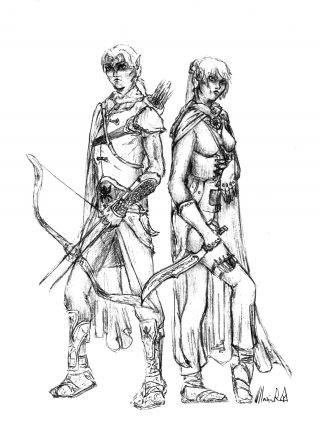I often partecipate in a Facebook group where people can give comments and critics to other people’s art. Most of the artists are great, and it’s always a pleasure to give a little feedback to one’s piece (“try to move that tree on the right to balance composition” or little stuff like that) and see that the person took you seriously. Watching so many styles helps with my visual library, and giving feedback trains my critical eye.
Unfortunately, there’s always “that” person: usually they’re beginners, but it happens with trained people too. You tell them, “the neck is too long”, and the answer is, “but it’s my style!”
No, it’s not. Not yet, at least.
Most beginners just start drawing characters they like in ways they like. This is great! When you create something for yourself, there’s no going wrong. But since it’s made by yourself for yourself, is very hard to find other people who will like it. Moreover, if you always draw in the same style, it is almost impossible to improve. If you want to keep drawing for yourself and your friends, please do, and I wish you the best of happiness! But if you aim to become a commercial artist, this is not the way.
You still have a lot to learn, we all do. But don’t protect your creation with sword and shield, yelling “it’s my style!” everytime you receive a critic. I fell into that pit many times myself: your piece has a strong meaning to you, but getting attached to it isn’t leading you anywhere.

“Stop oppressing my style!”
Courtesy of myself, ten years ago.
What is your style?
I once met a guy who wanted to write a fantasy novel: he had all the characters, the settings, the story, and never stopped talking about them! But when I asked what his favourite book was, the answer left me baffled. “I don’t read! I only write!”
Uhm, really? How can you write something if you don’t know anything about writing? I understand you must not taint your style with other people’s vision, but you cannot create something new without knowledge of what has been done before. He couldn’t notice that his story was old and trite, because he didn’t know the environment in which he wanted to work.
If you want to be really good, you need to start from the basics: anatomy, shadowing, color theory, perspective… there is a lot to learn, much more than you would guess! Each of us, regardless of style, need to start from there. No exceptions.
Breaking the rules is a great way to stand out. But you can afford to break a rule only if you know beforehand how the rule work!
The concept to art isn’t to paint things wrong on purpose so they stand out. It’s to study, painstalkingly, how things are and how other people depicted them, and then use your knowledge to sum up the shape and make it your own. Once you have all the tools and knowledge, you can move towards your real style. It may be manga, realistic, abstract, made of clean lines or big patches of primary colors, but you’ll know it’s your style, and you earned it.